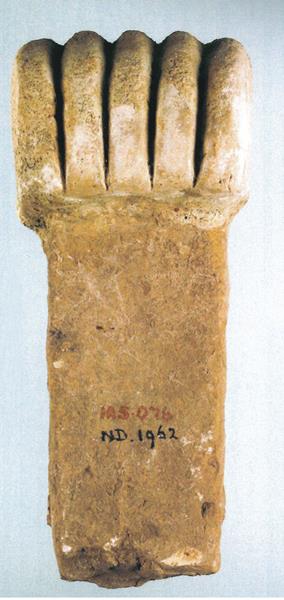
A. Hammer
B. Architectural element
C. Gardening tool
D. Drumstick
E. Amulet
Answer: We don’t know—but probably (B) Architectural element
There is no definitive interpretation of this object from the excavations of Assyrian Nimrud.1 Known as “hands of Ishtar” or simply “clay hands,” artifacts like this one have archaeologists puzzled.
Weighing between 1.7 and 4.5 pounds, clay hands are either a life-size or slightly larger combination of a clenched fist and a forearm, with five uniformly stylized fingers. The texture of the fist is noticeably smoother than that of the arm. The hands are made of kiln-fired clay, and some are decorated by a coat of blue or yellow glaze. Many examples are inscribed with cuneiform texts—either on the side of the hand or on the arm. Known inscriptions invoke Mesopotamian deities, and many mention the Assyrian king Ashurnasirpal II.
Although their use is unknown, the clay hands were most likely architectural elements. Their shape suggests that the arm part was inserted in the wall, with only the hand left protruding. In such a position, they could have served as miniature corbels (placed under roof-beams) or to drape furnishing textiles.
Known examples of clay hands have come from the major Assyrian cities of Ashur, Kar-Tukulti-Ninurta, Dur-Sharrukin, Nimrud and Nineveh. Almost all were found in temples.
Already a library member? Log in here.
Institution user? Log in with your IP address.

